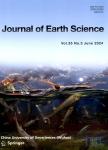Co-Seismic Surface Rupture and Recurrence Interval of Large Earthquakes along Damaoyaba-Litang Segment of the Litang Fault on the Eastern Margin of the Tibetan Plateau in China
Co-Seismic Surface Rupture and Recurrence Interval of Large Earthquakes along Damaoyaba-Litang Segment of the Litang Fault on the Eastern Margin of the Tibetan Plateau in China作者机构:Sichuan Earthquake Agency^Chengdu 610041China School of Geological Engineering and GeomaticsChang'an UniversityXi'an 710054China
出 版 物:《Journal of Earth Science》 (地球科学学刊(英文版))
年 卷 期:2021年第32卷第5期
页 面:1139-1151页
核心收录:
学科分类:070801[理学-固体地球物理学] 07[理学] 0708[理学-地球物理学]
基 金:This research was supported by the“China Seismic Active Fault Exploration,Central-South Segment Project of the NorthSouth Seismic Belt”of the China Earthquake Administration the National Science Foundation of China(No.41372114)
主 题:Litang fault surface rupture active fault recurrence intervals paleoearthquake eastern Tibetan Plateau
摘 要:The Litang fault is a left-lateral secondary shear zone in the Sichuan-Yunnan active block that accommodates the tectonic deformation associated with the eastward extrusion of the upper crust of the Tibetan Plateau. Based on 1 : 50 000 geological mapping of active faults, the Litang fault consists of three geometric segments, the Cuopuhu, Damaoyaba, and Litang segments, in the west of Litang, which are divided by the of Haizi Mountain uplift and the wide-angle bending and branching of the fault near Jinchanggou. This study also identifies the surface rupture of the A.D. 1890 earthquake, which is distributed intermittently along the ~28 km long Damaoyaba segments and ~25 km long Litang segments. The maximum horizontal displacement is 4.1 m along Damaoyaba segments, and 4 m along Litang segments. The rupture involves typical left-lateral shear movement. The two ruptures are divided by discontinuous segments or gaps that are ~18 km long;thus, the total surface rupture is approximately 71 km long. The estimated moment magnitude was M_(w)7.3±0.1. A comprehensive analysis of data obtained from 5 trenches excavated along the Damaoyaba and Litang segments and the trench data by Xu et al.(2005) identifies age constraints of the 4 most recent paleoseimic events occurred B.C. 1468±54–1340±25, B.C. 52±25–A.D. 76±47, A.D. 1115±90, and A.D. 1890, respectively. The recurrence intervals are 1 415±80, 1 104±104, and 775±90 a, which are consistent with quasi-periodic earthquake recurrence behavior. The average recurrence interval is 1 098±112 a.



